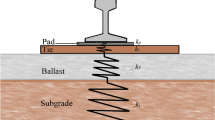Abstract
Railroad crossties (sleepers) are a key component of the track structure and play an important role in the support of the track structure and the distribution of train loading through the track. The condition of the crossties has been traditionally monitored by visual inspection, which has, in recent years, been supplemented with automated crosstie inspection systems. These provide more accurate information about the condition of each individual crosstie and as such are important in planning and optimizing tie replacement. By using inspection data taken from the same track in different years, it is possible to determine the degradation of ties, and corresponding life of the ties, and to develop improved tie life models that take into account local conditions. The aim of this paper is to provide a method to predict and model tie life based on support condition, as defined by the condition of adjacent crossties. Tie life is modeled using mathematical techniques, such as piecewise reconstruction which allows for the determination of the probability of tie failure as a function of loss of support. The analysis approach, using Dijkstra’s algorithm and Markov chains, is based on the use of tie condition data from two different inspections performed over a span of 3 years. The dataset, which consists of approximately 100,000 ties, included tie inspection data for inspections carried out on the same track during the period 2016 to 2019. Ties are grouped based on their support condition, specifically the loss of support associated with the presence of poor or failed ties on either side of the study tie. The results present average tie life as a function of different support conditions and confirm the fact that loss of support contributes measurably to premature tie failure. This reduction in tie life is presented as a function of tie support condition and compared to earlier studies.









Similar content being viewed by others
Change history
21 July 2021
A Correction to this paper has been published: https://doi.org/10.1007/s40515-021-00182-7
Notes
Railroad cross-ties are often referred to as sleepers.
The Georgetown Rail “Aurora” tie inspection system.
This was done using the R open source environment. Graphs were generated using the igraph package.
For combined groups, the loss of support is calculated using a weighted average of the individual group loss of support values.
The previous study referred to here is the one presented in Reference (Zarembski et al. 2020) at the 2020 annual AREMA (American Railway Engineering and Maintenance of way Association) conference.
From group F as shown in Fig. 4.
References
Bisht, R.K., Dhami, H.S.: Discrete mathematics. Oxford University Press (2015)
David, F.: Markov chains. Springer Science & Business Media (2012)
Dijkstra, E.: A note on two problems in connexion with graphs. Numer. Math. 1, 269–271 (1959)
Federal Railroad Administration, Track Safety Standards. 49, 213 (2019)
Georgetown Rail. (n.d.) https://georgetownrail.com/Track-Inspection/Aurora. [Online]. Available: https://georgetownrail.com/Track-Inspection/Aurora
Grinstead, J.L.S.C.M.: Chapter 11: Markov chains. In: Introductory Probability. American Mathematical Society, Providence (1997)
Hay, W.W.: Railroad engineering. John Wiley and Sons (1982)
Huang, C.-Y., Lai, C.-Y., Cheng, K.-T.: Fundamentals of algorithms. In: Electronic Design Automation, pp. 173–234. (2009). https://doi.org/10.1016/b978-0-12-374364-0.50011-4
Kerr, A.D.: Fundamentals of railroad track engineering. Simmons Boardman Press, Omaha (2003)
Leiphart, C.: Railroad track maintenance part one: the tie gang. (2020). [Online]. Available: https://brickmodelrailroader.com/index.php/2020/08/14/railroad-track-maintenance-part-one-the-tie-gang/
Lovett, A., Dick, T., Ruppert, C.: Cost and delay of railroad timber and concrete crosstie maintenance and replacement. Transportation Research Record Journal of the Transportation Research Board (2015)
Raslear, T., Gordon, J.E., Marquis, B.P.: Track inspection time study. U. S Department of Transportation Federal Railroad Administration (2011)
Spedicato, G.: Discrete time Markov chains with R. R J. (2017) R package version 0.6.9.7, https://journal.r-project.org/archive/2017/RJ-2017-036/index.html
Wai-Ki, C., Huang, X., Ng, M.K., Siu, T.-K.: Markov chains. Models, algorithms and applications. Springer (2006)
Zarembski, A.M., Gauntt, J.C.: Development of a tie usage index for matching wood performance and operating conditions. Railroad Tie Association (2001)
Zarembski, A.M., Holfeld, D.R.: On the prediction of the life of wood crossties. American Wood Tie Preservers Association Conference, Pittsburgh (1997a)
Zarembski, A.M., Holfeld, D.R.: On the prediction of the life of wood crossties. Railway Tie Association (1997b) Available: https://www.rta.org/assets/docs/Research/LifeCycle1/on%20prediction%20of%20the%20life%20of%20wood%20ties.pdf
Zarembski, A.M., Palese, J., Soufiane, K., Grissom, G.: Effect of tie condition distribution on life expectancy of wood crosstie. American Railway Engineering and Maintenance-of-Way Association Conference (2020) (virtual)
Zarembski, A.M., Parker, L.A., Palese, J.W.: Use of comprehensive tie condition data in cross-tie maintenance planning and management on the BNSF. American Railway Engineering Maintenance Association Annual Technical Conference (2002)
Zarembski, A.M., Parker, L.A., Palese, J.W., Bonaventura, C.: Computerized tie condition inspection and use of tie condition data in cross-tie maintenance planning. Int. Heavy Haul Conf. (2003)
ZETA-TECH: Validation of the Traditional USDA Forest Products Laboratory Tie Life Curve- Using Recent Data from US Class 1 Railroads. Railway Tie Association (2008)
ZETA-TECH: Determination of effect of introduction of dual treatment (borate-creosote) ties on average tie life and wood tie life cycle costs. Railway Tie Association (2011). Available: https://www.rta.org/assets/docs/rta%20dual%20treatment%20study%202011915.pdf
ZETA-TECH Associates: Field demonstration of the use of track strength data to optimize tie replacement requirements for high speed operations. Railway Tie Association. (2006). Available: https://www.rta.org/assets/docs/RTASponsoredResearch/WoodCrosstiePerformanceandInspection/field%20demonstration%20of%20track%20strength%20data.pdf
ZETA-TECH Associates: Wood crossties an engineering perspective. Railway Tie Association. Available: https://www.rta.org/assets/Resources-PDF-Articles/Engineering%20Manual%20Revised%20Without%20Questions.pdf
Acknowledgements
The authors would like to acknowledge the US Department of Transportation University Transportation Center program (RailTeam UTC) for their sponsorship of this research. The authors would also like to acknowledge Georgetown Rail (GREX) for providing the data used in this analysis and for their sponsorship of the preliminary research that laid the groundwork for this research.
Author information
Authors and Affiliations
Corresponding author
Additional information
Publisher’s Note
Springer Nature remains neutral with regard to jurisdictional claims in published maps and institutional affiliations.
The original version of this article unfortunately contained a mistake in table 2. The second column of the last row exceeds the gutter.
Rights and permissions
About this article
Cite this article
Soufiane, K., Zarembski, A.M. & Palese, J.W. Effect of Adjacent Support Condition on Premature Wood Crosstie Failure. Transp. Infrastruct. Geotech. 9, 302–320 (2022). https://doi.org/10.1007/s40515-021-00168-5
Accepted:
Published:
Issue Date:
DOI: https://doi.org/10.1007/s40515-021-00168-5




